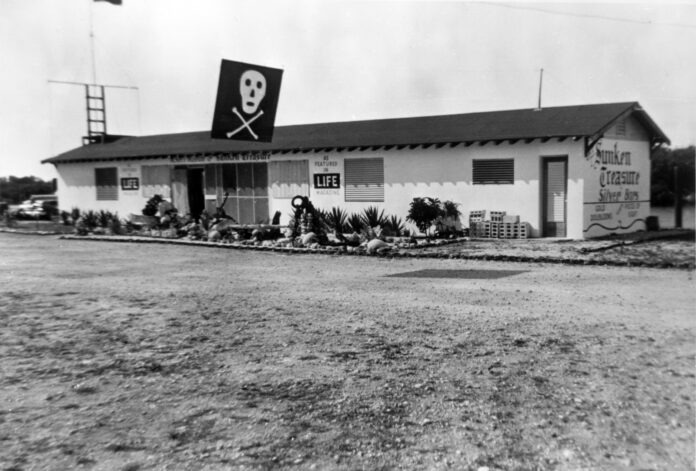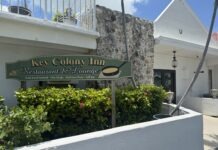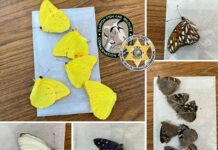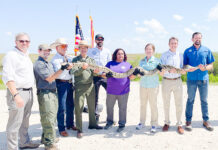
Stumbling upon an old story of buried treasure is always a thrill. Stumbling upon a real buried treasure would be super cool, but that requires a different kind of hunting and digging than I do.
The heaviest tool I operate, at least daily, is a keyboard. Still, when I dig up some historical nugget I have seen for the first time, it feels like gold and always makes my breath catch for one second, sometimes two.
One of my favorite stories occurred on Plantation Key in the 1970s when the island still had a sandy ridge built up over hundreds of years on the Atlantic side. This treasure story involved a bulldozer working to clear away a 75-foot section of the ridge. After the bulldozer’s operator cleared about 10 inches off the top, he stepped off the machine to inspect his work.
While walking over the area, he noticed several blackened pieces of metal and bent over to pick one up. It was about the size of a quarter. He rolled it over in his hand and scratched its surface with a finger. It was a coin, an old Spanish coin. According to a story published in 1975 and written by Art McKee, who inspected the coin, “Then they saw what proved to be the mint mark, O/M, and the assayer’s ‘F’ mark, as well as the Spanish coat-of-arms consisting of lions and castles and a cross. The pieces were eight-reale Spanish silver coins – actual pieces of eight!”
According to McKee, the bulldozer operator and a work associate picked up 74 coins over a 10-by-15-foot area. While most coins were undated, some were marked 1732 and 1733. How did the treasure end up on Plantation Key? McKee’s theory was that the coins were contraband smuggled aboard one of the 1733 treasure fleet shipwrecks. The sailor tried to swim for shore but drowned in the process, and after his body washed ashore, it became covered over time.
McKee added credence to the story by saying, “A small portion of a human skull was found on the beach.” The story does not explain what happened to the rest of the body.
The Plantation Key story was documented, and Art McKee, who is considered the father of modern treasure hunting, adds additional authenticity. McKee, too, had his Museum of Sunken Treasure on the same island. However, other stories just make you want to scratch your head. For instance, there is a story about buried treasure uncovered on Key Largo that is nothing short of unbelievable.
The story was printed in as many as 200 newspapers nationwide, including the Omaha Daily News on Dec. 19, 1925. The headline read: “25-Year Hunt Yields Buried Treasure – Weatherbeaten Mariner Unearths Cache of Doublooms and Pieces of Eight Near Key Largo, Florida.”
The story, written by Ben Hecht, was fascinating. Hecht wrote that “Captain Bill Lofton came whooping into Key Largo this evening aboard a fivver loaded to the gunnels with doblooms [sic] and pieces of eight.” A fivver is an old junker car. “The old captain conveyed the treasure, pail by pail, into the kitchen of the strange looking house which he has built out of ships gone down off Key Largo.”
According to the story, Lofton discovered the treasure on the bank of Angelfish Creek.
The Spanish coins, estimated to be worth $250,000, were buried 6 feet down in 25 “huge earthen jars.”
Hecht wrote that when Lofton came barreling into town that day, he spoke to the crowd who gathered around his vehicle to see the treasures: “You all been calling me ‘Crazy Bill Lofton,’ he declared, on account of my spending all my life hunting for pirate treasure. Well, I just found it right where I knew it was, and right where the chart said it was. I want you folks to remember that I’m the deputy sheriff of Monroe County, and that I ain’t going to stand for no disorders on account of this treasure lying in my kitchen now.”
Allegedly, the discovery of buried Spanish treasure on Key Largo had a curious, if not reasonable, effect on the area. Hecht, who crafted the article, said, “Captain Lofton’s story has thrown Key Largo into an excitement reminiscent of the Klondike gold rush. According to telephone calls and telegrams received here, numerous craft are pulling out of the cities along the coast, fitted with shovels, diving suits and ‘treasure experts.’”
There was a follow-up to the story published in the Jan. 8, 1926 edition of the Kansas City Star — among other papers. The headline read: “Cap’n Bill Seeks a Guide.” According to the story, Lofton had traveled to New York City and sought someone to guide him around and show him a good time. “Captain Bill arrived here from Key Largo today prepared to interview his ‘guides.’ He was all dressed up in a silk hat and swallow tail coat.”
When asked what he was going to do in the city, “the ancient mariner replied he was going to scatter his pirate dublooms [sic] up and down New York City’s gay white way by the bucketful.”
Next week, we will dig deeper into the Captain Lofton story, Hecht, and how the pirate treasure came to be discovered. Hecht, by the way, was an Oscar-winning Hollywood screenwriter and author. Stay tuned for the rest of this one-of-a-kind buried treasure tale.




















